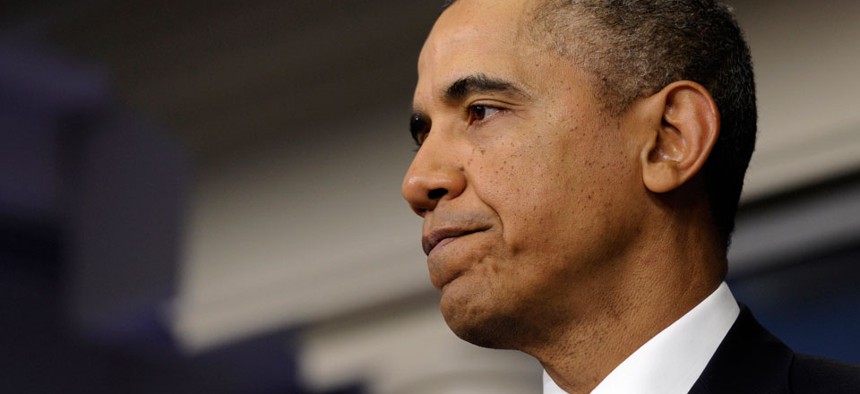
Susan Walsh/AP
Analysis: Obama's Incredibly Underwhelming Executive Orders
Recent White House moves to help workers may be well-intentioned, but they will achieve little.
President Obama tried to boost the fortunes of the aspiring middle class late last week by issuing an executive order to rewrite regulations that dictate which type of workers can collect overtime pay. It was a valiant effort on the part of the administration—and the president's second, recent attempt to prod the economy to work better for a wider swath of people, not just the uber-rich.
Yet over the next year, these moves will help only a fraction of working Americans. One executive order requires companies with new federal contracts to pay workers under those contracts a minimum of $10.10 per hour; the other order would rewrite the rules for overtime pay and ensure that a greater number of white-collar professionals can collect extra money for time worked over 40 hours a week. Yet these executive orders will do little to address the broader economic challenges the country faces like stagnant wages or the near-impossible job market for the long-term unemployed. (Does anyone remember them, those 3.8 million Americans out of work for six months or more?)
Obama's not entirely to blame for small-bore policies that fail to produce significant change. After all, Congress still controls the levers of government spending, and we know how well the White House and Capitol Hill get along. With no breakthroughs in this hyper-partisan environment, though, this is where we find ourselves—staring dumbfounded at a yet-to-recover labor market and leaning on marginal moves to prop it up.
Here's why Obama's recent executive orders on overtime pay and increasing the minimum wage for federal contractors will not take us far enough to improve the lives of the majority of working Americans:
Small impact. It's tough to gauge the potential effect of the Obama's new overtime rules because the Labor Department still needs to rewrite them—a process that an agency spokesman says could take the bulk of 2014. ("We expect that the department will then publish a proposal for public comment later this year," says the Labor Department's Jason Surbey.) That means the proposal to change the rules, not even the policy itself, won't come out until late 2014.
Still, it's possible to do some back-of-the-envelope estimates on the number of workers this could help. The Economic Policy Institute recently released a detailed paper that argues the Labor Department should make eligible for overtime workers who earn $970 dollars a week or less. This would be a major bump up from the current law's threshold of $455 dollars a week. The paper's authors (including Jared Bernstein, the former chief economist to Vice President Joe Biden) estimate this would lift the wages of 5 million to 10 million workers. Meanwhile, increasing the minimum wage for federal contractors could help up to a couple of thousand workers.
At most, these two executive orders, if fully enforced, will benefit roughly 10 million working Americans. For context, as of 2012, there were 103 million Americans working full-time and year-round, according to the latest data from the U.S. Census Bureau. That's not the worst stat, but it also not going to entirely make up for stagnant wages and a labor market that continues to work better for companies than for American workers.
Nothing will happen right away. The other rub about the two executive orders is that they won't go into effect right away, probably not even before the 2014 midterm elections. If the Labor Department is not planning to even release a proposal of its overtime pay plans until later this year, then we're potentially looking at very late 2014, even 2015 as a time frame for when this actually becomes policy. The same goes for the increase in minimum wage for federal contractors. That order only applies to new contracts issued by the government moving forward.
Enforcement. Both executive orders require the Labor Department to enforce them, and it's unclear if the federal agency has the manpower. Can it keep tabs on all future federal contractors to guarantee they pay the higher minimum wage of $10.10? And what about enforcing the more nuanced overtime rules, which depend on the classification of the worker, as well as the amount of money he or she makes per week? "That's millions of small establishments that will be effected by this. They will be hard to monitor," says Harry Holzer, a professor of public policy at Georgetown University and former chief economist at Labor. Anecdotally, we're already seeing reports that some workers who live in states that raised the minimum wage on Jan. 1 are not seeing those extra earnings show up in their paychecks. The new rules could follow a similar script.
The lengthy economy to-do list remains long. Both recent executive orders on workers' wages show that Obama is trying to achieve some lasting reforms for American workers, still battered by the recession. But these policies score political points for Democrats more than they spur economic growth. The federal government still needs to figure out a way to ensure that the economy expands at a faster clip. We need more jobs to be created, not just low-wage ones—and more pressingly, we need to develop an agenda to reconnect the millions of out-of-work and underemployed Americans to the labor market. "The president proposed many ideas in 2011, like tax credits, public service employment, and infrastructure projects, that were never enacted but would have helped change the job market," Holzer adds. "What you need is a much tighter labor market." Unfortunately, those are the bigger picture questions that executive orders like these simply do not tackle.






